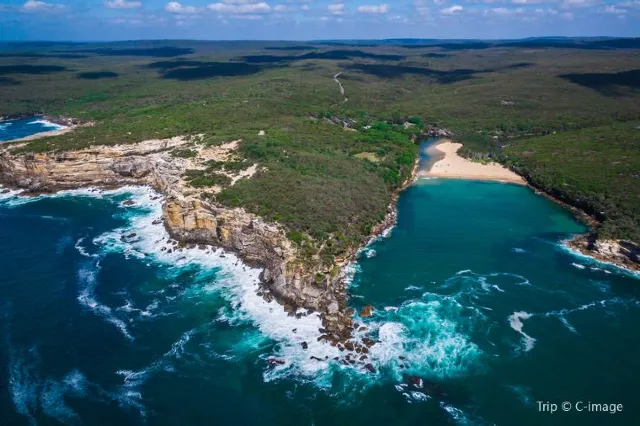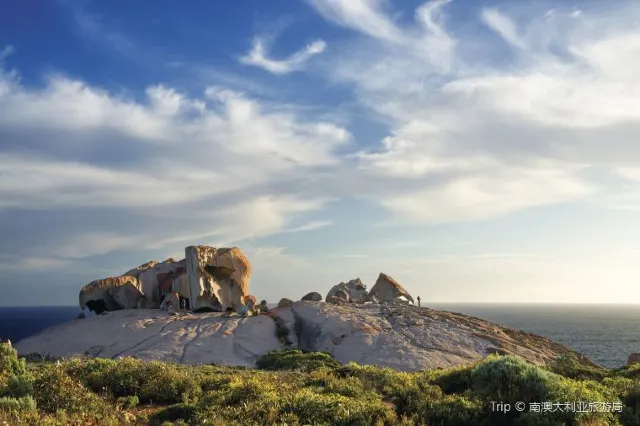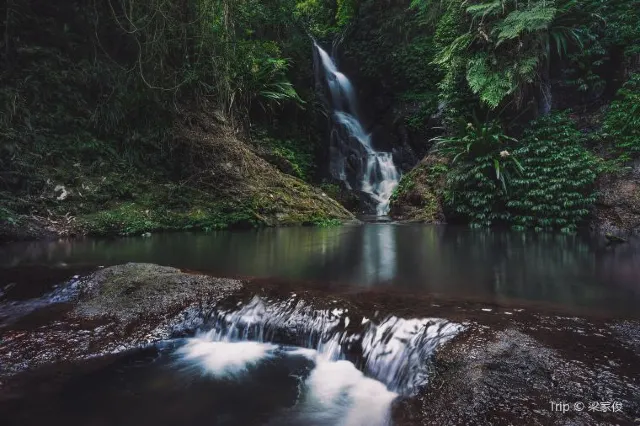Explore Nature: 15 Most Beautiful Australian National Parks
Catalogue
- Daintree National Park
- Watarrka National Park
- Noosa National Park
- Great Sandy National Park
- Litchfield National Park
- Namadgi National Park
- Mungo National Park
- Mole Creek Karst National Park
- Royal National Park
- Flinders Chase National Park
- Great Otway National Park
- Nambung National Park
- Springbrook National Park
- Lamington National Park
- Mary River National Park
Show More
Australia is the country for nature lovers. The size of the country lends to its wide variety of landscapes with mountain ranges, deserts, tropical rain forests, and beaches to be explored. The lush hinterlands, sea cliffs, red dirt outback, and dense rain forests, and canyons are all waiting to be explored. One of the best things about this country, however, are the sheer number of Australian National Parks that are waiting to be discovered by curious nature enthusiasts. Extraordinary and rugged, these national parks are simply sublime and wondrous. Filled with the most amazing serpentine creeks, lavish rainforests, and rough cliffs and each of these parks offers a little bit of the unpredictable to its visitors.
Located up in Far North Queensland, the Daintree National Park was founded in 1981. It is part of the Wet Tropics of Queensland and is a World Heritage site among Australian National Parks as of 1988. One entrance to the park is south of Daintree River at the Mossman Gorge, which has a visitors centre too. The Mossman Gorge offers a spectacular walkthrough with picturesque explorations such as the Baral Marrjanga, rex Creek Bridge, and Lower River Track. Visitors get to spot fauna such as Victoria’s riflebird and Boyd’s forest dragon.
The Cape Tribulation section, too, has some charming spots with lowland rainforest, flatlands, and exotic, untouched beaches. The traditional owners of the Daintree National Park are the Aboriginal People of Eastern Kuku Yalanji. Much of the forest including the ‘bouncing stones’ hold spiritual significance to the aboriginals. The stones on the Thornton beach are elastic in nature and can be bounced off each other. The park is home to over 400 species of birds. The wompoo fruit dove, buff-breasted paradise kingfisher, striped possum, swamp wallaby, platypus, chameleon gecko, amethystine python, keelback, and white-lipped tree frog are some of the species that you can come across in the national park.

The Watarrka National Park is situated in Northern Territory of Australia. It is about 1316 kilometres from the Territory capital of Darwin and is 323 kilometres from Alice Springs. The park was established in 1989 and takes its name from the aboriginals of the land. The main attraction of the Watarrka as one of the Australian National Parks, is the Kings Canyon which is very popular among tourists. It lies at the western end of the George Gill Range. The Kathleen Springs, which lie to the south of the Kings Canyon are much visited too. There are three different walks at the canyon. The Kings Creek walk traces the bottom of the canyon and opens onto a platform with a splendid view. The Rim walk lines the top of the canyon and takes about four hours. The steep incline at the beginning of the walk is nicknamed ‘ Heartbreak Hill’ due to its steepness. Halfway into the walk, a descent detours down to the Garden of Eden, which is a permanent waterhole surrounded by beautiful flora. Tourists can spot the zebra finch, grey-headed honeyeater, peregrine falcon, and black-breasted buzzard out here.

This 4000-hectare national park is one of the Australian National Parks located near Noosa Head. It is divided into 4 sections, namely the East Weyba section, Emu Mountain section, Peregian section, and the Headland section. Many beaches in the park provide excellent swimming locations. Although camping is banned, other activities like rock climbing, surfing, snorkelling, and fishing are conducted in the park.
The rainforests are dominated by kauri pines and hoop pines with wallum heaths, pandanus plants, and eucalyptus trees seen in certain areas. Christmas bells and Swamp orchids blossom during spring and add a touch of colour to the Peregian section. Animals and birds such as the glossy black cockatoo, eastern yellow robin, short-nosed bandicoot, brushtail possum, and crimson rosella are found in abundance. Migrating humpback whales can be spotted in the headlands section.

The Great Sandy National Park is situated in the Fraser Coast Region of Queensland. This is one of the Australian National Parks that is home to pristine beaches, swamps, creeks, mangrove forests, rainforests, heathlands, freshwater lakes, and large sand dunes. Divided into the Cooloola Recreational Area and the K’Gari section, the park covers 1,85,000 acres of area. Places in the Cooloola area have been designated as Important Bird Area by BirdLife International due to the large population of black-breasted button quail, beach stone curlews, green catbirds, and regent bowerbirds. It also has eastern ground parrots and a large number of emus. Whale watching, four-wheel drives, and bushwalking are popular activities inside the park. Fraser section (K’Gari) is the only place in the world where large trees grow in sand. The Great Sandy is known for its colourful sand created by old sand mixing in with clay to create a consolidated mass. Hues that can be seen in the park sand are red, yellow, and brown. Camping is allowed upon obtaining permits.Fines can be incurred for leaving behind waste at the campsite or for feeding the Dingo population in the park.

The Litchfield National Park was declared as one among Australian National Parks in 1986 and attracts millions of visitors each year. Some of the flora in the park include woodland flora like banksias, terminalias, Darwin stringybark, Woolybutt, and Grevilleas. Fauna includes antilopine kangaroos, agile wallaby, red flying fox, orange leaf-nosed bat, fawn antechinus, and sugar gliders. The Finniss river area has many saltwater crocodiles. The main attractions in the park include several falls such as Florence, Tolmer, Buley, Wangi, Tjaetaba, and Surprise creek falls. The Blyth Homestead and Bamboo creek too attract tons of visitors. The magnetic termite mounds are popular with tourists. The mound aligns its wedged shape to the north in response to the environment. The shape of the mound allows the temperature to remain stable inside the mound. There are multiple bushwalks in this national park including the ones at Florence creek, Wangi Falls Walk, And Greenant Creek.

Namadgi is one of Australian National Parks in the south-west of Australian Capital Territory. It borders the Kosciuszko National Park. The habitat of the park ranges from grassy plains with gum forests to alpine meadows. The water catchment areas of this park supply 85% of Canberra’s water requirement. The name of the park comes from the traditional custodian aboriginals of this region. The park protects a part of the Australian Alps that have stupendous granite mountains. Winter sports such as skiing are conducted in the park, although downhill skiing is not permitted. Temperatures can change very quickly from cold wintery nights to warm summery days, and the flora and fauna reflect the same. Eastern Grey Kangaroo, Wallabies, Rosella, Wombats, Raven, and magpie can be found in this national park. The International Union for Conservation of Nature has classified the park as a Category II Protected Area. In 2008 it was also added to the Australian National Heritage List. There is an aerial view of the Corin Dam in the park. The Dam has an uncontrolled side-channel spillway across the Cotter river. Visitors can also take a walk through the trails and visit the Ginini Flatlands, Booroomba Rocks, and Bendora Arboretum inside the Manadgi National Park.
Mungo is a protected national park in south-west New South Wales. The most stunning feature of this stunner amidst Australian National Parks is Lake Mungo. It is the second biggest of the ancient dry lakes. The park is also of value for the archaeological remains of the Mungo Man and Mungo Lady (the oldest human remains discovered in Australia) that were discovered in the park. Explore the parks rich Aboriginal history and take long walks inside. Camping is permitted near Lake Mungo and is a fun thing to do with family. Wildlife spotting can be done around Zanci Pastoral Loop, Rosewood picnic area, and Round tank area. The Willandra Lakes World Heritage site. The site is of great significance to the Ngyiampaa, Southern Paakantyi, and Muthi Muthi aboriginal people, and it is said that their ancestral spirits dwell in these regions. The park is always open but sometimes tends to be closed due to bad weather or fire dangers.
Discover Tasmania’s best in Mole Creek Karst National Park. It is a part of the Tasmanian Wilderness-World Heritage Site. The park has a characteristic network of caves that have extensive bone deposits, stalactites, and stalagmites that are stunning to view. Of these, the Marakoopa caves is known for its gorgeous Glow Worm display with two featured streams, beautiful caverns, flowstone features, shawls, and rim pools. The Mole Creek Karst systems, like most Australian National Parks, are home to several species of endangered, rare, and vulnerable beetles, bandicoots, eagle, crayfish, and Cave Harvestman. Sphagunum peatlands across the park have led to the creation of many sinkholes across the region and are found scattered among the eucalyptus forests. Flora include black gum, stringybark, silver wattle, black peppermint, and white gum. Endangered, rare, and vulnerable flora include sallow wattle, slender tick trefoil, Poison rice flowers, and narrow leaf pomaderris.

Just south of Sydney, the Royal National Park is a protected park, which is the second oldest national park in the world after Yellowstone in the US. The national park is home to settlements of Bundeena, Maianbar, and Audley aboriginals. The wide variety of terrain in the park spans coastal cliffs, small inlets, high plateaus, and deep river valleys. Geologically the region mainly consists of Triassic Hawkesbury Sandstone with some sections having newer shale capping. The national park has several systems such as the mangroves and salt marshes, Riparian forests, Tidal rock shelves with rock pools, beaches, and valley floors. The pools are home to the blue-line octopus, which is fatally toxic. It is very hard to spot and inhabits the rock pools. Tourists to Australian National Parks are advised not to enter the rock pools as the sting of the octopus could result in mortality within minutes. Park highlights include the Wattamolla beach, Figure 8 pool south of Burning Palms, Eagle Rock, Curracarong waterfalls, and Lady Carrington Drive.

Flinders Chase is one of Australian National Parks located at the west end of Kangaroo Island in South Australia. It is known to be a sanctuary protecting several endangered species and is also the ground for certain geological marvels. The park consists of three vivid parcels of land- Cape Du Couedic, The Gosse Land, Lighthouse reserve at Cape Borda. The first acquired lands as part of the park were done to protect flora and fauna under the reserve Act of 1919. The sanctuary has species that were introduced from the mainland as well as local species. Koalas and platypus were among the species introduced into the habitat. Little penguins were seen in here but are, though now, to be extinct due to an increase in long-nosed fur seals. The park is home to ‘Remarkable Rock’, naturally-sculpted rock formations balanced on top of a granite outlier. Cape Du Couedic is another geological monument that was formed when sea levels started to rise at the start of the current geological epoch. It consists of metamorphic rocks that belong to Middleton Sandstone.

Great Otway is known for its scenic beauty, dotted with waterfalls here and there. This includes the three cascades of Triplet Falls, too, which are a popular attraction in the park. The park consists of three camping areas at Aire River, Johanna, and Blanket bay. The park is known to cover coastlines as well as hinterlands and has access to beaches and forests of the Otway Ranges. All of these are accessible through walking trails. A significant koala population inhabits the grounds of the Aire river campgrounds. Migrating humpback whales, bottlenose dolphins, and southern right whale have been spotted just off the coastline. The stream banks have bioluminescent glow worms, which are the larvae of fungus gnats. The park has also been classified as an Important Bird Area among Australian National Parks due to its population of rufous bristlebirds, pink robins, and striated fieldwrens. Ghost fungus, which glows a light green at night is easily spotted at night on trees, while Ruby Bonnet fungus and Flame Fungus are a red coloured growth that can be distinguished easily due to their colour.
Nambung is known foremost for its Pinnacle deserts, which are limestone formations that cover a large area in the park. Located in the Wheatbelt region of Western Australia, the park derives its name from an Australian indigenous word that means winding. The park consists of coastal dunes and flowering plants in low heathlands and beaches along Kangaroo Point and Hangover Bay. Around the area at Lake Thetis, a boardwalk allows visitors to view Thrombolites, which are erections built by cyanobacteria. Fossilized thrombolites have been dated as far back as 3 billion years ago. The flora and fauna here is abundant and includes red fox, honey possum, red kangaroo, silver gull, red-capped plovers, sand goanna, yellow-faced whip snake, and ravens. The only amphibian spotted here is the sign-bearing froglet. Flora includes sea nymph, cowslip orchid, coastal wattle, and acorn banksia. Sea-lions and dolphins are seen around the year at the coastline in these Australian National Parks.
Located in the hinterlands of Gold coast, Queensland, Springbrook lies near the McPherson ranges. It is a part of the Shield Volcano Group of the World Heritage sites for Australian National Parks. The waterfalls that run through the Natural Bridge section are a marvellous sight, and commercial operators conduct night tours in adjoining caves to view the glow-worm lights. The natural Bridge is nature’s wonder created by rocks that were undercut by the waterfalls to create a cave beneath the falls and a pothole like connection on top. The Springbrook section has several waterfalls, and the walking trail passes at least 9 of these falls. All sections of the park allow picnics. The reserve has rock overhangs, cliffs, rock falls, tall beech trees, giant brush box trees, sugar gliders, possums, birdwing butterflies, and red-necked pademelons. Camping overnight and swimming in the cave pools are prohibited.

Lamington is a Natural Heritage Park known well for its waterfalls, birdlife, rainforests, mountain views, and walking trails. Most parts of the park are remnants of Tweed Volcano. The Nerang, Albert, and Coomera rivers all originate in the Lamington National Park. The park, like some of Australian National Parks, has many waterfalls, caves, and wildflower heaths, which make the perfect trail for bushwalking through the park. The colourful flora and fauna of the park attract scores of visitors all year round. There are many plants in Lamington which are not found anywhere else on earth, like the Underground Orchid, Everlasting Daisy, and Peach Myrtle. Strangler figs and red carabeen, yellow carabeen, and rosewood are also found in Lamington. The regent bowerbird and the crimson rosella are often spotted by tourists. Tourists can visit Elbana falls, Morans falls, and several others that dot the national park at regular intervals.

The Mary River National Park is a melange of several small reserve areas that protect and surround the Mary River Catchment area. It has over 13 conservation areas, of which some are not contiguous with each other. The park is a perfect place for picnics around the Arnhem highway. Rockhole and Couzens lookout are other places where you can access the Mary River system. Barramundi fishing is popular at Rockhole, and Couzens offers breathtaking sunset views like many of the other Australian National Parks. Brian Creek Monsoon Forest is noteworthy for its stark contrast to the surrounding woodlands. Shady Camp offers a boat ramp, picnic areas, and other facilities that make it an endearing place to go to with family. Mistake billabong provides a shaded area from where tourists can enjoy sights of the billabong. During winters, flooding can cause roads to be sealed off.
Natures excesses are aplenty in every region of Australia. The country is a paradise for lovers of all things nature. The geological makeup, flora, and fauna in this country is stunning and can take a lifetime to cover. So start planning your trips, and cover as much ground as you can in this life.
Trending Travelogues
Popular Trip Moments
Popular Travel Types
Popular Attractions
Popular Ranked Lists
Popular Destinations
Recommended Attractions at Popular Destinations













Site Operator: Trip.com Travel Singapore Pte. Ltd.






